Deciding on a soccer formation should be the easier part of coaching your team. However, it can be a tough decision to make when you need to take into consideration the weaknesses of your team as well as the strengths and weaknesses of your opponents. The 4-2-3-1 soccer formation is perfectly balanced, allowing the team to attack fluidly while also giving the team stability while defending
What is the 4-2-3-1 soccer formation?
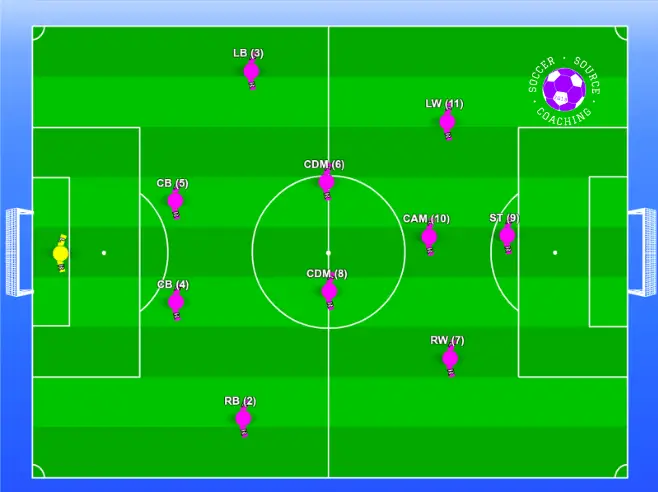
The 4-2-3-1 formation is made up of 4 lines of players.
The first line of players make up the defensive line, which includes 2 center backs and 2 fullbacks
There are 2 lines of midfielders in this formation, with the first line of midfielders made up of 2 defensive midfielders.
The second midfield line is made up of 3 more attacking midfielders, a central attacking midfielder, a left winger, and a right winger.
The final line in the formation is the forward line and it is made up of a sole striker.
In this formation, you can also invert the wingers.
This means that the wingers will naturally cut inside, creating more space in the wider areas for the pitch for the fullback to exploit.
Obviously, every formation has a goalkeeper too!
4-2-3-1 soccer tactics explained
The purpose of this formation is to better balance the attack and defense of the team.
As the 4-2-3-1 formation is made up of 4 lines of players when they are attacking they have greater passing options and angles when on the ball.
Equally, when the team is defending they can reduce the amount of space between defensive lines.
Making it harder for opposition attacking teams to exploit space when trying to attack.
The tactics and positioning of a soccer formation may change depending on whether or not the team has possession of the ball.
The 4-2-3-1 soccer formation is no different.
Attacking tactics of a 4-2-3-1 soccer formation
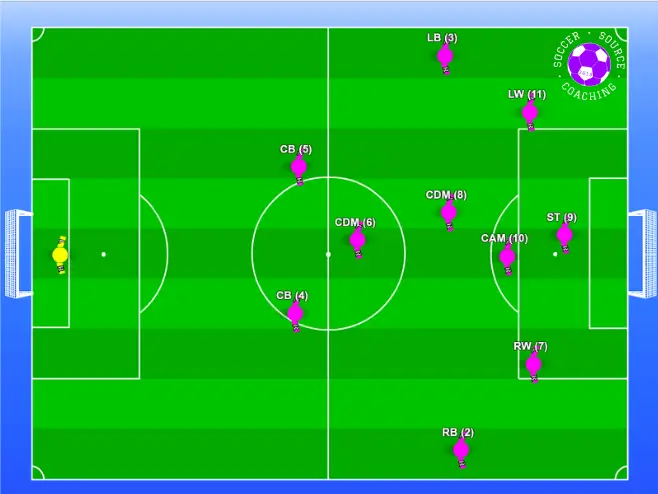
When attacking in the 4-2-3-1 formation, the goal is to overload the central areas and wide areas of the pitch.
In this formation, you want to look to get the central attacking midfielder on the ball as often as possible to create chances for your team.
When the central attacking midfielder gets on the ball, the fullbacks should be exploiting the spaces in the wide areas.
The left and right winger should be looking to make runs in behind the opposition’s defensive line.
In formation, the lone striker needs to play more of a target player role in the team and help link up play from the midfield to forwards.
When the team is attacking the central defenders will split with a defensive midfielder just sitting in front of them.
This puts the team in a good position to stop a counterattack if a change of possession occurs
Defending tactics of a 4-2-3-1 soccer formation
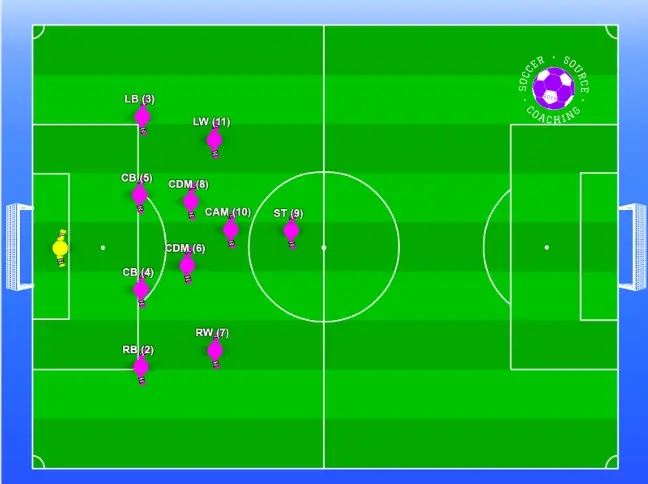
When defending in a 4-2-3-1 formation it will look like a 4-5-1 formation.
This will make it very hard for the opposition to find space in the central areas of the pitch to exploit.
The 2 defensive midfielders will sit in front of the defensive line with the central attacker midfielder just in front of them.
The wingers will drop back into a more defensive position ready to assist the fullbacks if they need help.
This will create a compact midfield 5 with a small triangle shape in the middle made up of the central midfielders.
The goal of this defensive 4-2-3-1 formation is to push teams into the wider areas of the pitch.
Either to force them out of bounds or make them play backward.
4-2-3-1 strengths and weaknesses
Like all formations, there are always strengths and weaknesses.
The 4-2-3-1 soccer formation is no different.
Here are the pros and cons you should take into consideration before deciding whether or not this formation will be a good fit for your team.
4-2-3-1 strengths
- Balanced formation
Out of all the soccer formations, this is one of the most balanced.
It allows the team to attack and commit players forward in the final third, however, the team is well-positioned to prevent any form of counterattack.
A team playing in this formation puts themselves in a great stance to take away points from any game.
- Great at creating attacking overloads
Attacking overloads can easily be created in the final third, regardless of whether the team is playing against a back 3 or back 4.
Overloads can be created in the central areas of the pitch with the central attacking midfielder coming with the striker and wingers.
Fullbacks can also create overloads in the wide areas of the pitch, combing with the wingers.
- Tough to break down defensively
When defending the 4-2-3-1 formation is incredibly tough to break down.
This is because the central areas of the pitch are incredibly company with the midfielders defending in different defensive lines.
In many cases, the 3 in the middle will outnumber the opposition’s central midfielders
The team is also very well protected in the wide areas providing that the wingers track back and provide support to the fullbacks
4-2-3-1 weaknesses
- Striker can be Isolated
In this formation, it is crucial to get support from the striker as quickly as possible.
Without getting close to the striker to offer support the number of chances a team could create will drastically fall.
If the striker gets frustrated with the lack of service, they may drop deeper to receive the ball.
This will reduce the depth of the team and remove their outlet if they regain possession of the ball and need to relieve [ressure
- Wide areas can be exploited if wingers don’t track back
For the team to be defensively sound in the 4-2-3-1 soccer formation the wingers need to track back and support their fullbacks.
If the wingers fail to do this the opposition will be easily able to take advantage of the overloads.
For this formation to work you to ensure that your wingers are prepared to work hard going back as much as they do going forward
- Relies on the central attacking midfielder to create chances
The creation of chances in this formation falls onto the shoulders of the central attacking midfielder.
If opposition teams can limit the amount of the ball the attacking midfielder sees, then they will prevent a large number of dangerous chances from being created.
4-2-3-1 player roles and responsibilities
The player roles and responsibilities will change in the 4-2-3-1 formation depending on whether the team is in or out of possession of the ball.
When the team is attacking the players will look to stretch out the pitch as much as possible to create more attacking opportunities.
However, when defending the players will want to remain as compact as possible to become as hard as possible to break down.
Center back roles and responsibilities in a 4-2-3-1
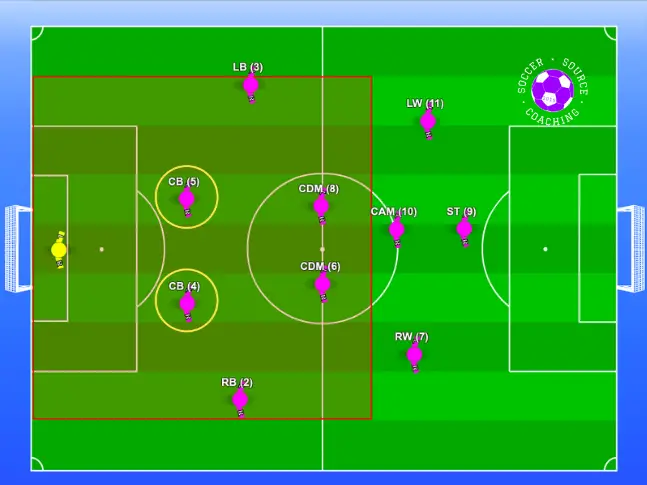
The center backs will form the heart of the defense.
Typically, there will be one center back who will look to attack the ball with the other center back dropping off and clearing up anything that gets past the first center back.
However, both center backs must be comfortable with the ball at their feet.
This will give them a huge advantage when playing against teams who like to press.
The center backs can also add an attacking threat from set pieces.
Here is a complete guide on how to be a center-back in soccer.
Center back roles and responsibilities when attacking
When in possession of the ball the center backs must drop off and create angles when attempting to play out of the back.
Not only will this give them more time and space on the ball but it will also give the central midfielders more space to check in to receive the ball.
This will make playing out the back a lot easier as the team will be able to break the oppositions pressing lines.
When a team is in a more advanced position on the pitch the center backs should move from side to side depending on which side the ball is on.
This is will give their teammates an option to play backward if there is no option to play forward or sideways.
In set pieces, such as attacking corner kicks, center backs should look to take advantage of their areal ability
Center back roles and responsibilities when defending
Being at the heart of the defense one of the main responsibilities of the central defender in the 4-3-2-1 soccer formation keep the team organized and compact when defending.
This is achieved through effectively communicating with your teammate to ensure everyone is on the same page when defending.
These are the different types of presses in soccer, see how the defensive shape changes depending on what type of press the defending team is implementing.
In this formation, the center back is also responsible for organizing the teammates to defend against set pieces.
When defending against the long balls one center-back should be competing against the opposition forward while the other center-back plays more of a sweeper role.
Fullback roles and responsibilities in a 4-2-3-1
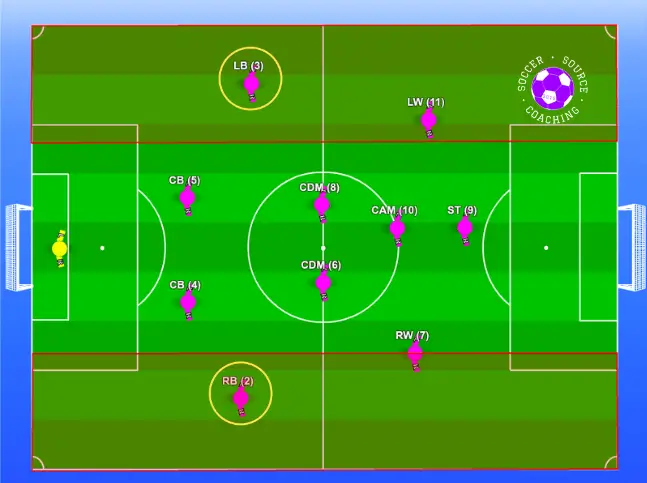
In the 4-2-3-1 formation, the fullback plays an important role when the team is attacking or defending.
The fullbacks in this formation need to be quick and physically fit to deal with the amount of running they will be doing.
When playing this formation teams should look to get their fullbacks involved in play as much as possible.
Here is a complete guide on how to play as a fullback in soccer.
Fullback roles and responsibilities when attacking
When attacking in the 4-2-3-1 soccer formation the fullbacks are the players who are going to provide the team with the width.
By spreading out wide the fullbacks are stretching the opposition team.
This will give them more time and space when they receive the ball in these areas.
Even if they do not receive the ball, by stretching the opposition out of position they will be creating pockets of space for the central player to exploit.
When attacking with wide areas the fullback should look to get crosses into the box as frequently as possible.
To get into these crossing positions they need to be confident in their attacking 1v1s or look to play give-and-go passes with central players
Fullback roles and responsibilities when defending
As well as playing a crucial role when the team is attacking in this formation they also have a critical role to play while defending too.
In the 4-2-3-1 formation, the fullbacks’ main responsibilities are to prevent dangerous crosses coming or opposition wingers from cutting inside.
Their main focus should be to press the opposition winger and stand them up.
This will allow them to capitalize on any mistake that the opposition may make.
To be a good defender you do not always have to win the ball.
Forcing the opposition to play backward or forcing them out of bounds is just as effective as trying to win the ball.
The fullbacks also have a responsibility to cover the center backs too.
Especially if the opposition team likes to play on the counter with a fast striker.
Defensive midfielder roles and responsibilities in a 4-2-3-1
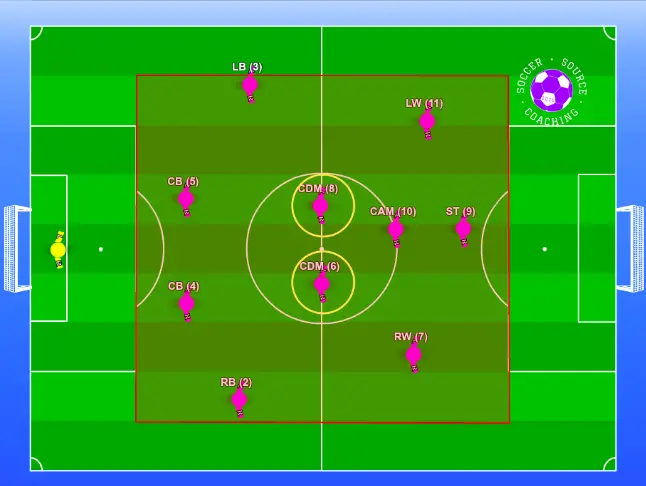
In the 4-2-3-1 formation, there are 2 defensive midfielders.
These players are the engine room of the team.
They give more freedom to the attacking players because of the hard work they put in behind the scenes.
The success of the formation will largely depend on these 2 players.
Here is a complete guide on how to play as a defensive midfielder in soccer
Defensive midfielder and responsibilities when attacking
The defensive midfielder’s role in the attack is to help the team pivot and change the points of the attack when going forward is not an option.
1 defensive midfielder will drop and sit just in front of the central defenders, while the other defensive midfielder will play a slightly more advanced role linking to the forward players.
The defensive midfielders will need to have a wide range of passing.
This will allow the team in the 4-2-3-1 soccer formation to play intricate passes through opposition defensive lines.
As well as playing longer cross-field passes to quickly exploit space in the wide areas.
Defensive midfielder and responsibilities when defending
The main responsibility of the defensive midfielders in a 4-2-3-1 formation is to serve as a protective screen in front of the back 4.
By picking up space just in front of the back 4 they will make it incredibly difficult for the opposition team to provide service to their forward players.
The defensive midfielders need to be disciplined in their positioning.
If they get dragged out of position, a massive space will be created for opposition attackers to receive the ball.
It is also their responsibility to track late runners into the box when a dangerous cross comes into the box.
Attacking midfielder and responsibilities in a 4-2-3-1
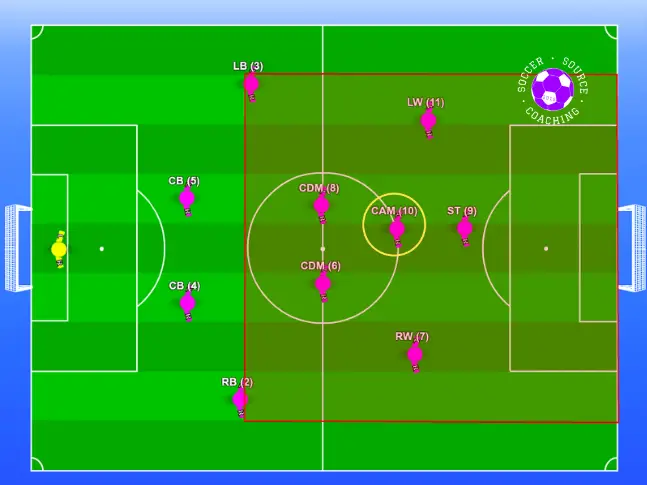
In the 4-2-3-1 formation, the attacking midfielder is the player the team is going to look to create goal-scoring opportunities.
The attacking midfielder should always be looking to receive the ball on the half turn and in between opposition defensive lines.
They are the player that is going to help move the ball from the midfield to more attacking areas of the pitch.
This a complete guide on how to play as an attacking midfielder in soccer
Attacking midfielder roles and responsibilities when attacking
The most important thing that an attacking midfielder must do is to create gaming-winning moments for their team.
This is done by:
- Playing on the half turn
- Scanning the area so they are aware of their teammates’ runs
- Finding space in between defensive lines
- Making runs into the blind spots of opposition players
As well as contributing by assisting teammates they should be looking to score goals themselves.
However, they shouldn’t always get tunnel vision when there is no option to play forward.
Playing sideways or backward is a great way to maintain possession of the ball to change the point of attack.
As the striker is playing as a lone forward the attacking midfielder should look to support them as frequently as possible.
Either dropping off to receive the ball short or by looking to make runs beyond the striker to create the overload.
Attacking midfielder roles and responsibilities when defending
The attacking midfielder along with the striker should be the first player leading the high press in the 4-2-3-1 formation.
They should close off the passing angles of the opposition players and force them into areas of the pitch where teammates’ can step in to win the ball easier.
This will put the team on the front foot when attempting to win possession back of the ball.
When the team is defending in their defensive third, the attacking midfielder will play just in front of the defensive midfielders making up a defensive block of 5.
The role of the attacking midfielder is here to pressure the opposition player so that they play backward or to the side.
This will make it harder for the opposition team to play dangerous penetrative passes through the central areas of the pitch.
Winger roles and responsibilities in a 4-2-3-1
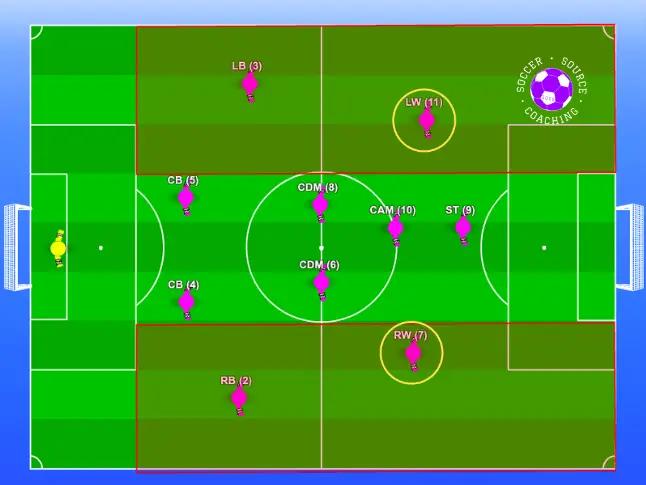
There are 3 ways that a winger can create goal-scoring opportunities for the team in a 4-2-3-1 soccer formation.
They can:
- Cut inside and drive toward to goal to shoot or cross
- Go down the outside and deliver dangerous crosses into the box
- Make runs in behind that start from in between the center-back and fullback
However, the winger must always fulfill their defensive responsibility otherwise this can leave the fullback vulnerable to an opposition overload.
This is a complete guide on how to be a winger in soccer
Winger roles and responsibilities when attacking
As a winger in the 4-2-3-1 soccer formation, you must look to support the lone striker.
This can be done by:
- Getting close to them to play combination passes around the opposition defenders
- Run beyond the striker to give them a passing option going forward
- Delivering crosses into the box from wide areas for them to attack.
The winger should also be aware of the runs that their fullback is making.
In some instances, it may be better for the winger to cut inside to allow the full-back to have more space in the wide areas of the pitch.
In other instances, it may be better for the winger to make an underlapping or over-lapping run to support them.
Winger roles and responsibilities when defending
When pressing and defending in the opponent’s half the main role of the winger in this formation is to cut off passing angles and block off forward passes.
This is effective at helping the team regain possession in a dangerous position on the pitch.
The winger should look to stand up to the opposition player and force them into a mistake to capitalize on.
However, when defending in their half it is essential that the wingers track back and support their fullbacks.
This will prevent an attacking overload in the wide areas, that the opposition could capitalize on.
Striker roles and responsibilities in a 4-2-3-1
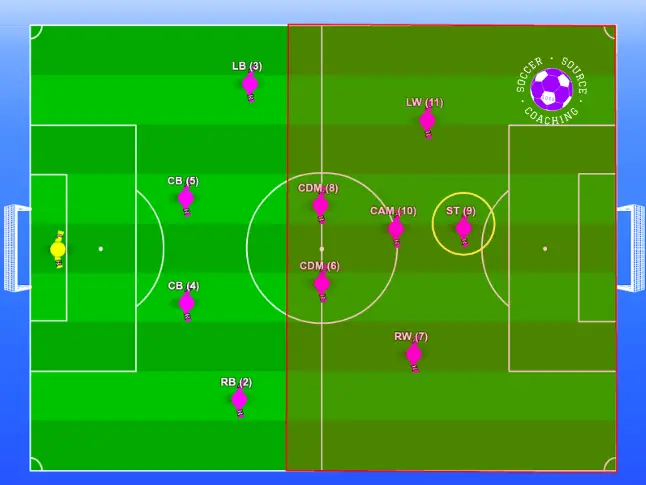
In this 4-2-3-1 formation, the striker is playing as a lone forward and needs to be a team player if the team wants to score goals.
Playing as a lone striker will mean that they will have to hold up the ball and bring teammates into play.
The striker may not get as many goals as they would like but it means that they can create lots of goal-scoring opportunities for their teammates.
Here is a complete on how to be a striker in soccer
Striker roles and responsibilities when attacking
The main role of the striker is to act as a target player in the 4-2-3-1 soccer formation.
They will do this by playing in front of the opposition center-backs and looking to receive the ball to feet or look flick on any longs balls played to them.
The striker should look to occupy the space between the 2 center-backs, playing both of their blind spots.
This makes it easier for them to check in short to run in behind or check out to receive the ball short.
When crosses come into the box the striker should be looking to attack the front post or the back post
Striker roles and responsibilities when defending
When defending in the opponent’s half the striker is the first player leading the press.
They should focus on identifying pressing triggers and press as soon as they see one.
Once they begin pressing they should close down the space from an angle, forcing the opposition to play into certain areas of the pitch.
This will help their team try to win the ball back in a more advantageous part of the pitch.
When defending in their half the striker should continue to close down the passing angle but without over-committing.
The goal is to force the opponent backward and side-to-side.
4-2-3-1 attacking patterns
In the 4-2-3-1 soccer formation, there are several different ways that players can combine passes to create dangerous opportunities.
Here are 5 examples of different attacking patterns of play teams could use in this formation
4-2-3-1 attacking pattern of play to get the ball out wide to the winger
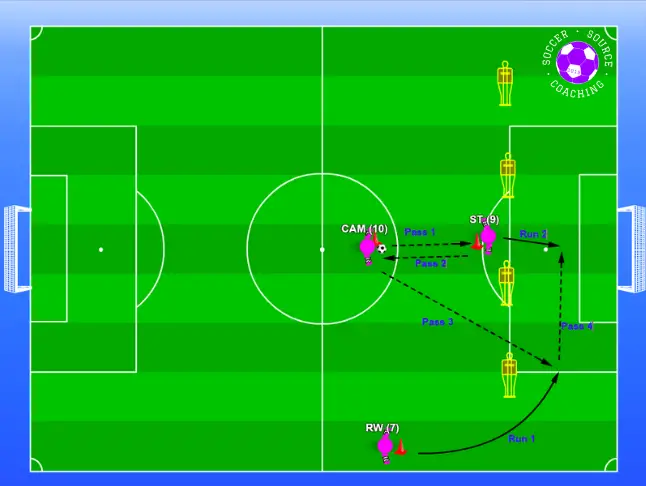
The purpose of this 4-2-3-1 attacking pattern of play is to create a crossing opportunity by playing a pass that splits the opposition center back and fullback
4-2-3-1 attacking pattern of play to get the ball out wide to the fullback
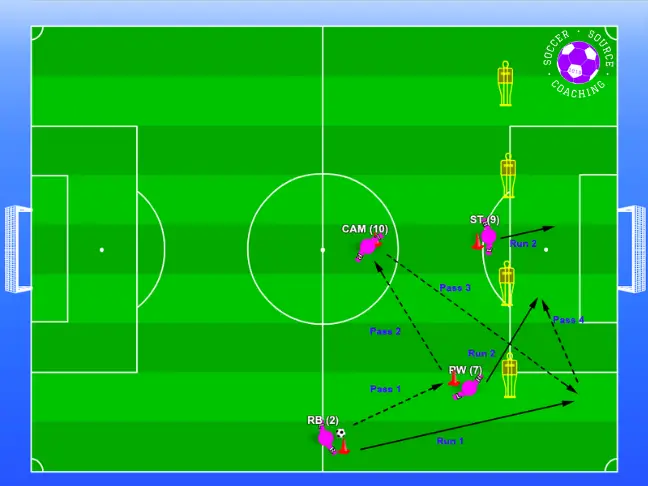
The purpose of the 4-2-3-1 attacking pattern of play is to get the ball out wide to the fullback so that they can deliver a cross into the middle.
To help create space for the fullback the winger will make a run inside to drag the opposition fullback into a more central position.
4-2-3-1 attacking pattern of play for an underlapping run
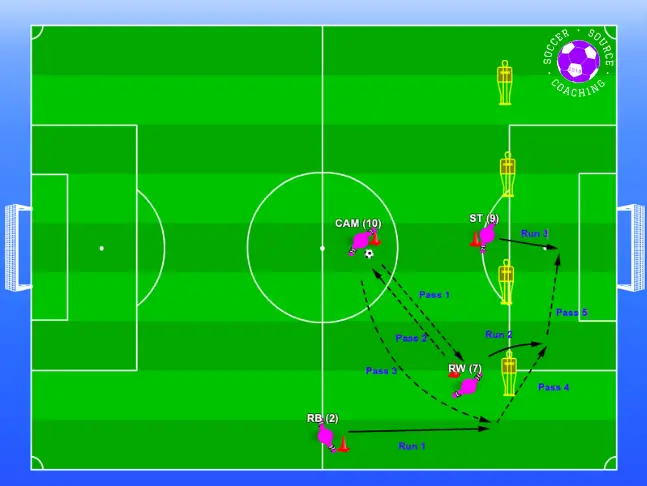
The purpose of this 4-2-3-1 attacking pattern of play is to split the opposition fullback and center back to allow the winger to make a successful underlapping run.
By quickly playing the ball outside to the fullback, should give the winger enough space to make a run in behind the opposition defense.
4-2-3-1 attacking pattern of play to split the center backs
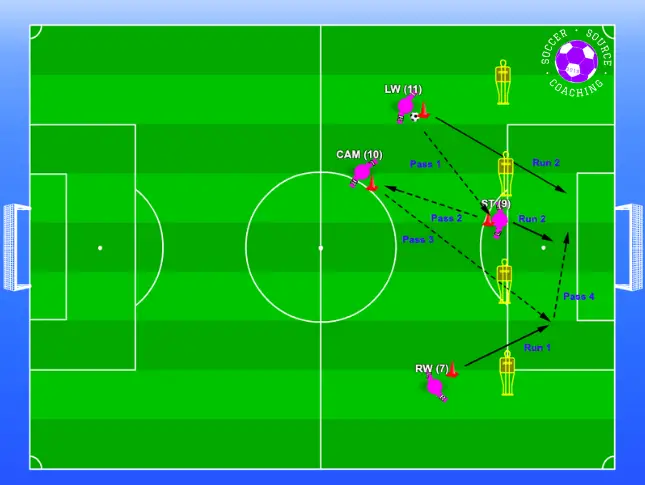
The purpose of this 4-2-3-1 attacking pattern on play is to try and drag defenders out of position so that a third-man run from the winger can exploit space in the central areas
4-2-3-1 attacking pattern of play to create an overload in the central area
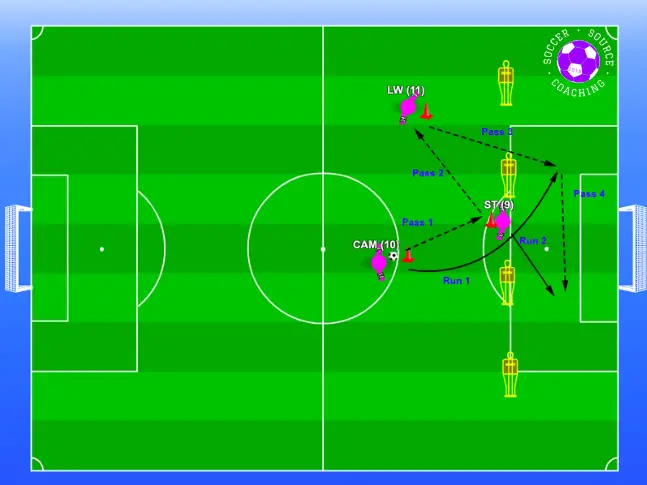
The purpose of this 4-2-3-1 attacking pattern of play is to create an overload in the central areas to allow the attacking midfielder to receive the ball.
Depending on the quality of the pass the attacking midfielder can either look to shoot or cross the ball back across the box
Teams that use the 4-2-3-1 formation
Teams that have used the 4-2-3-1 soccer formation effectively would be Valencia and Liverpool.
Both of whom were managed by Rafa Benitez.
This analysis goes into depth about how the system would work and some slight variations.
Is the 4-2-3-1 a good soccer formation to use?
Yes, the 4-2-3-1 is a good soccer formation to use.
It is great for teams:
- That wants to attack but doesn’t want to get caught in the counterattack
- To crowd out the central areas of the pitch to gain control of possession
- That wants to be hard to breakdown when out of possession of the ball
- That has a striker that is great at holding the ball up and bringing teammates into play
This is a solid soccer formation to choose for any team!
However, before you make your decision you need to assess the strengths and weaknesses of your team to ensure that the 4-2-3-1 formation brings out the best in your players!
If you don’t this formation would be a good fit for your team, here are some other options:
- 4-4-2 soccer formation
- 4-3-3 soccer formation
- The 4-5-1 soccer formation
- The 4-1-4-1 soccer formation
- 3-4-3 soccer formation
If you are unsure here is a summary of the best soccer formations for every play style
Thank you for taking the time to read the breakdown of the 4-2-3-1 soccer formation!
If you know a coach that would find this post useful then please share it with them using the social media buttons below.
Thank you,
Toby
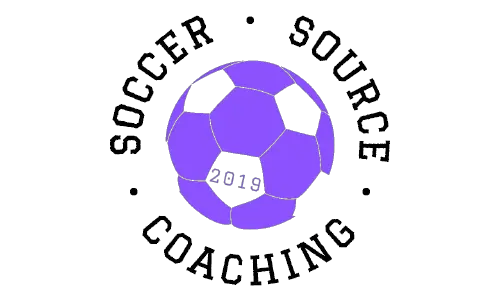
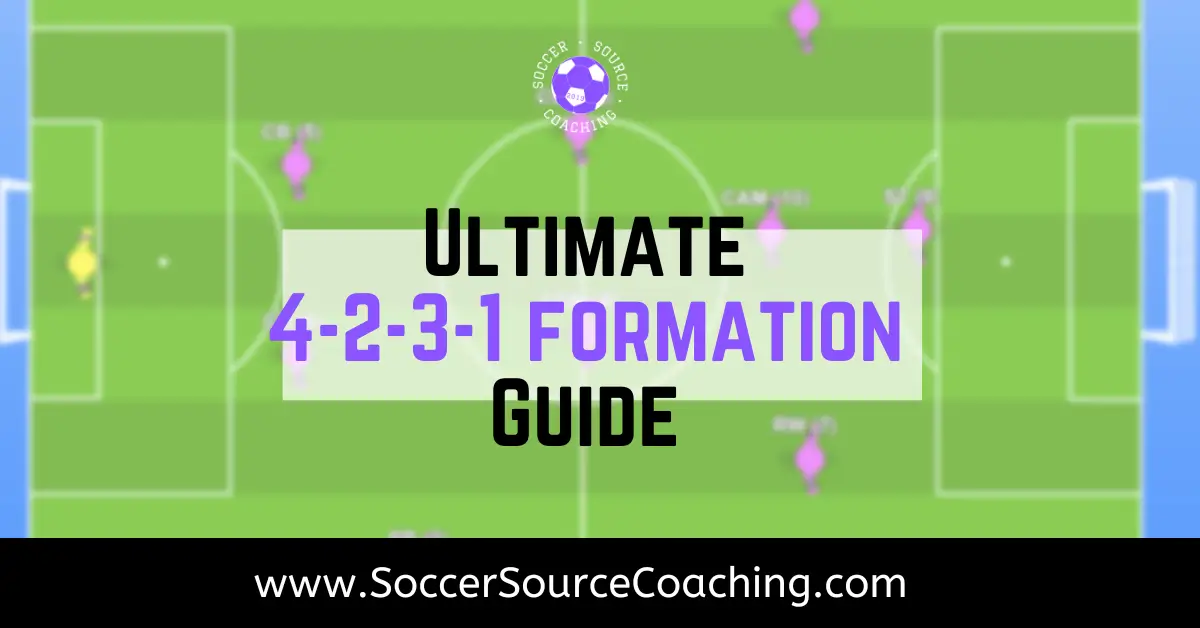
2 thoughts on “4-2-3-1 Soccer Formation | Best Guide”
Comments are closed.